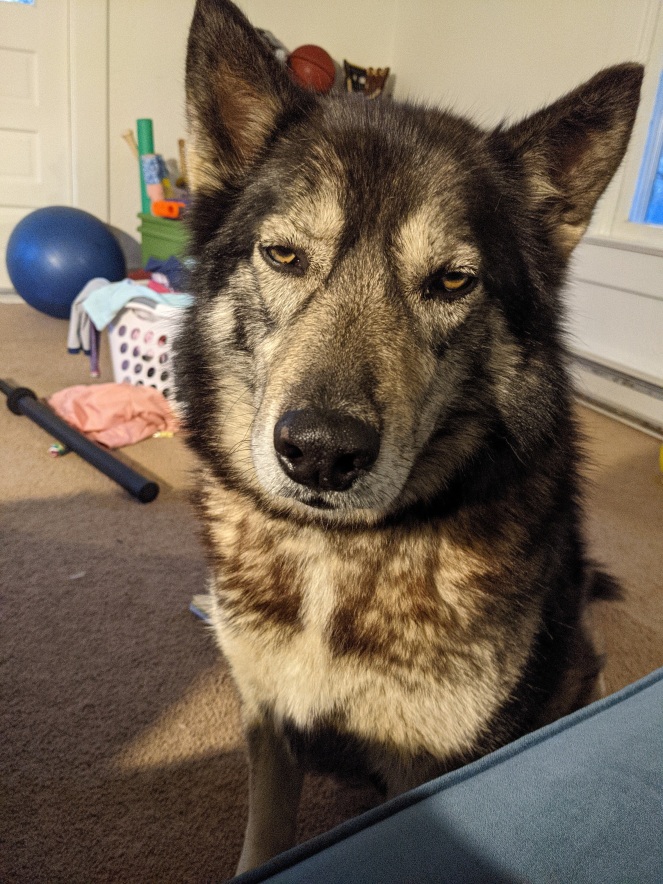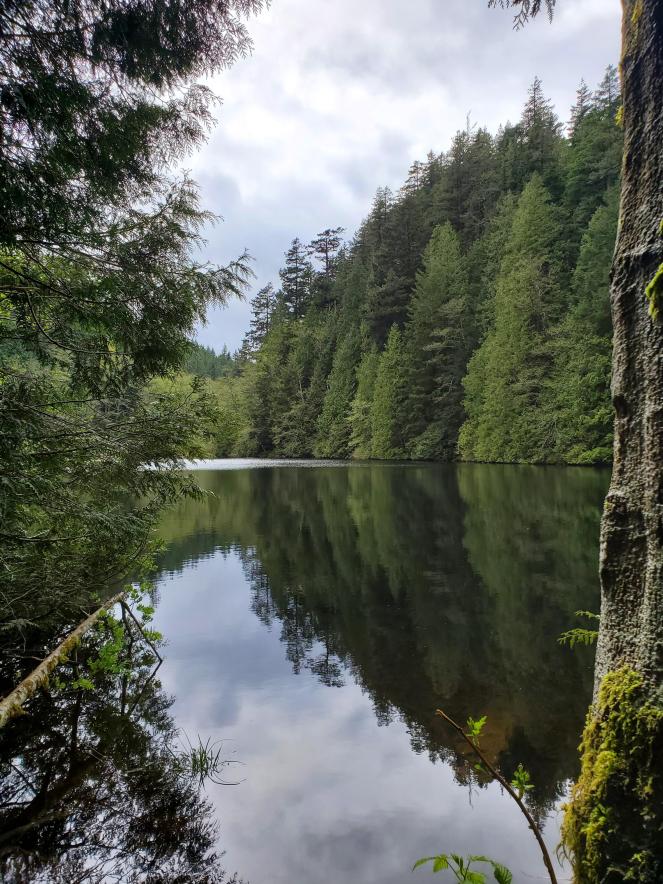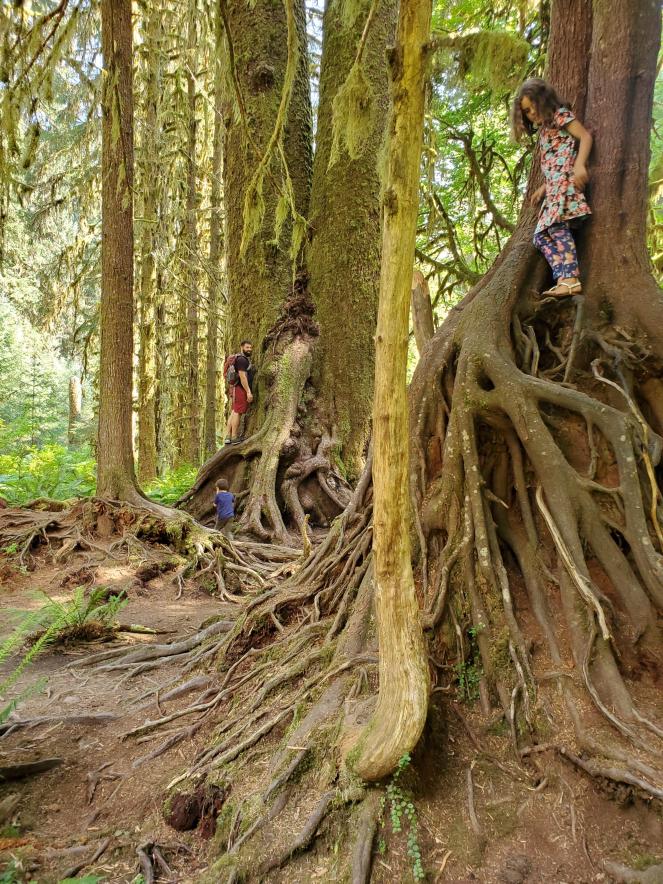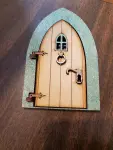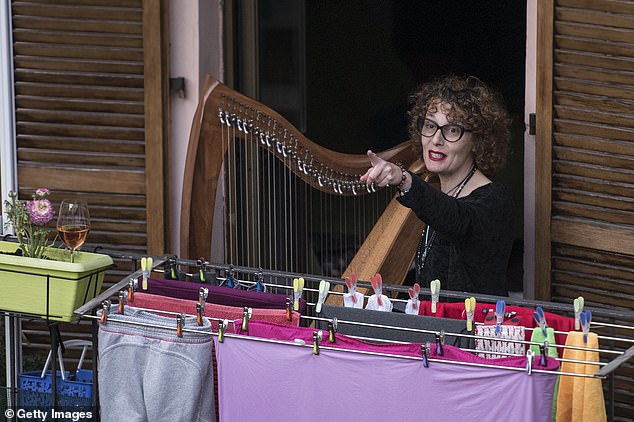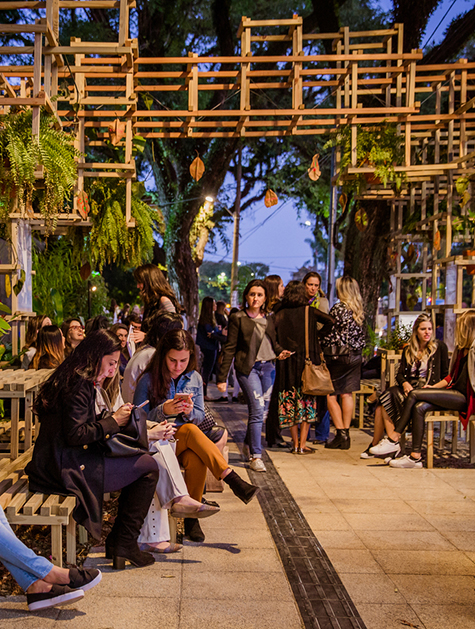|
 ASLA 2020 Urban Design Honor award. Yongqing Fang Alleyways: An Urban Transformation. Guangzhou, China. Lah D+H Landscape and Urban Design ASLA 2020 Urban Design Honor award. Yongqing Fang Alleyways: An Urban Transformation. Guangzhou, China. Lah D+H Landscape and Urban Design
People living in dense cities are among the least happy. Their rates of depression are 40 percent higher than other populations; and their rates of anxiety are 20 percent higher. Why? Because the built environment is directly linked with happiness and well-being, and too often urban environments fail to put people at ease.
In a session at the American Planning Association’s virtual conference, Justin Hollander, professor of urban and environmental planning and policy at Tufts University, said planners, landscape architects, and architects have a responsibility to design a built environment that increases well-being. Through his fascinating research on cognitive architecture, he has found "we are deeply influenced by our surroundings" — even more than we know.
"We have an automatic (non-conscious) response to shapes, patterns, and colors. Our minds are like icebergs — we are only aware of less than 5 percent of our responses to our environment," Hollander said. These findings, which are covered in greater detail in his book Cognitive Architecture: Designing for How We Respond to the Built Environment, co-authored with Ann Sussman, have significant implications for the planning and design of communities.
Hollander argued that "humans are wall-hugging species. Well-defined corridors and streets encourage our walking." (see image at top)
On an innate level, humans are also "programmed to look for faces everywhere." This may be why many traditional or vernacular homes and buildings almost look like faces, with a central door and windows on either side.
 A building that looks like a face / Ann Sussman, Tufts University A building that looks like a face / Ann Sussman, Tufts University
Humans connect with these forms because they help us tell stories about buildings and places. "We go to places because of stories we tell ourselves. We can imagine identities in these places. Tourist attractions always tell a story."
Given nature is our original context, humans also have an innate biophilia — a deep attraction to and affinity for nature. "It’s an artifact of evolution."
 ASLA 2020 Landmark Award. Millennium Park — A Fortuitous Masterpiece. Lurie Garden by Gustafson Guthrie Nichol / P. Psyzka and City of Chicago ASLA 2020 Landmark Award. Millennium Park — A Fortuitous Masterpiece. Lurie Garden by Gustafson Guthrie Nichol / P. Psyzka and City of Chicago
As we now understand, humans are drawn to landscapes that provide a refuge, a sense of safety, and prospect, a view of the entire scene, which supports that sense of safety. Storytelling is also important in landscapes, whether they are gardens, parks, or streetscapes. Humans are drawn to landscapes that provide clear sequences.
 ASLA 2018 Professional Award of Excellence. Brooklyn Bridge Park: A Twenty Year Transformation, Michael Van Valkenburgh Associates / Juliane Schaer ASLA 2018 Professional Award of Excellence. Brooklyn Bridge Park: A Twenty Year Transformation, Michael Van Valkenburgh Associates / Juliane Schaer
At Tufts University, Hollander is examining students’ cognitive responses to a variety of images of the built environment. Through eye-tracking software, "we can see the unseen — we can see what our minds are looking at an unconscious level."
In his lab, Hollander uses 3M’s visual attention software to map the path students’ eyes take across an image — where they fixate and experience an unconscious response to visual stimuli. In a study of 30 students, Hollander found they universally looked at the entrance and windows on a building first, ignoring the blank areas. And when he showed students’ eye tracks of a contemporary all-glass library, they fixated briefly on the edges, but the glass facade itself seemed faceless, almost invisible. They just looked at the sky. The image simply caused too much cognitive stress. (In the image below, the areas of highest fixation are in red, followed by orange, with blue indicating the least attention).
 Eye tracking of a traditional building and a glass library / Justin Hollander and Ann Sussman, Tufts University Eye tracking of a traditional building and a glass library / Justin Hollander and Ann Sussman, Tufts University
Hollander said eye tracking software shows that New Urbanist-style communities, which have homes closer to the street; traditional architecture that mimic faces; and sidewalks all "encourage walking." If a pedestrian can see a sequence — one, two, three, four homes in a row — they are more likely to want to walk down that row. He knows this because he could see the students unconsciously looking at all the facades down the street in a sequence.
In contrast, an image of a row of parking garages, with no clear doors or windows, caused students to scan for windows, quickly give up, and again look at the sky. "There was far less visual intensity, and it’s a less walkable environment."
Flags and columns succeed in grabbing attention, which is something consistent over millennia. Flags predate permanent settlements, and the ancient Greeks and Romans used columns in their architecture.
Why does this matter? Hollander argues that environments that are easier to fixate on cause less cognitive stress.
Megan Oliver, an urbanist based in Baltimore, Maryland, and founder of Hello Happy Design, said the research of Hollander and others is critical, because there is a "mental health crisis" in the U.S., particularly American cities.
People are constantly responding to the built environment and in turn trying to shape it in order to reduce the impact of environmental stressors, such as blank glass or concrete building facades, crowds, noise, and air pollution. These stressors combine to make people anxious, sick, and unhappy.
In contrast, happy places are designed to encourage pro-social behavior. This is because "people need social connections in order to thrive." Happy places help create layers of social relations, including "weak ties," which are actually very important. "Weak ties create a sense of belonging and identity. They build trust, which helps pull communities through challenges." Communities with higher weak ties and trust fought the COVID-19 pandemic better.
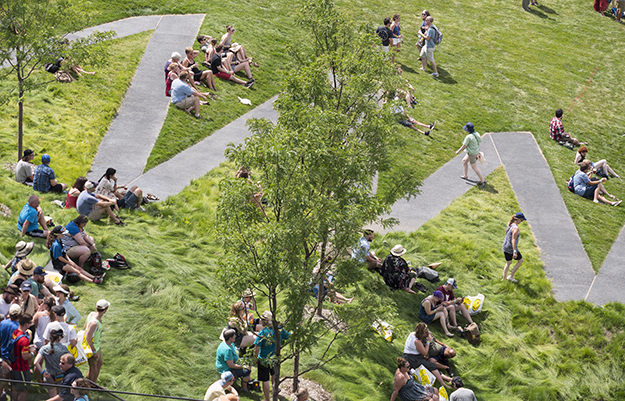 ASLA 2018 Professional General Design Honor Award. Walker Art Center Wurtele Upper Garden, Minneapolis, Minnesota. Inside | Outside + HGA / Theodore Lee ASLA 2018 Professional General Design Honor Award. Walker Art Center Wurtele Upper Garden, Minneapolis, Minnesota. Inside | Outside + HGA / Theodore Lee
Oliver argued that communities with pro-social behavior are also more inclusive and participatory and therefore better at shaping the built environment to meet their needs. The ethos in these communities is "change ourselves by changing the city." These communities shape their spaces, creating shared identity through gardens, public art, and other improvements that help reduce stressors. Happy places then go beyond "places we inhabit and become extensions of ourselves." These places enable us to "bond with the environment around us."
A related conversation, also with Hollander, occurred at the Congress for New Urbanism’s virtual gathering. In a rapid-fire Zoom roundtable, the debate about what makes people happy or not in the built environment continued.
Architect Don Ruggles, CEO of Ruggles Mabe Studio, argued that "humans are always looking for safe spaces. We think about survival every minute of the day. But beauty is equally as important. We have an intuitive response — it creates a sense of pleasure."
The problem, he argues, is that "our survival instinct is about five-to-seven times stronger than our pleasure instinct," so anything in the built environment that is a stressor overwhelms our ability to experience beauty. He called for designers to focus on projects that engage our parasympathetic system that create deep relaxation so that pleasure can be experienced.
According to Nikos Salingaros, professor of mathematics, architecture, urban, and complexity theory at the University of Texas at San Antonio, architects today are wed to a style rooted in 1920s Germany — the Bauhaus — that creates an unhealthy built environment. "Trillions of dollars are wasted on creating stylistically irrelevant glass boxes that are essentially invisible to people. Whole cities — districts, neighborhoods, and downtowns — have become invisible, because of the geometries and math of the structures built." Given humans are cognitively stressed by Modernist or contemporary glass buildings, these places are "close to malpractice, based on the medical evidence."
Instead, Salingaros called for privileging human connections through walkable, bikeable places. "Start with network connectivity. No giant blocks. Create intimate networks that are comfortable to humans." Furthermore, all urban spaces should be "continuations of those people-centric networks. Use the correct dimensions, apply pattern languages, and make the boundaries of buildings and spaces permeable."
Urban designers, architects, and landscape architects should be "applying mathematical symmetries at multiple scales. The urban, landscape, architectural, and ornamental scale should all be aligned through sub-symmetries" — or the entire design will fail. "The measure of success will be the flow of people."
He especially cautioned against contemporary buildings that purposefully try to be disharmonious — "these place intentionally violate symmetry laws," creating stress in their attempt to grab attention.
For Ann Sussman, an architect, author, and researcher, designers can retrofit environments that create stress and anxiety, but only to a degree. She pointed to a project in Somerville, Massachusetts, where the negative impact of the blank concrete wall of a parking garage was mitigated through public art and greenery. Students shown the blank wall and then an image of the redesigned wall while wearing eye-tracking monitors experienced higher visual fixation on the art.
But in the case of a car-centric suburb, with a wide road with few houses along it, even adding in sidewalks would do little to reduce the impact of its inherent car-centric nature. "As people look down the street, they can’t fixate on the sidewalk and therefore safety. There are some suburbs built in the 1950s and 60s that just will never be walkable. These places are too foreign to our brain architecture."
Unfortunately, new developments can have the problem. Sussman asked: "Why is the Seaport district in South Boston so loathed? It’s because people can’t focus on it — they can’t anchor their sight on the glass buildings, so their fixation is anchored to the sky."
 Seaport District, Boston / Signature Boston Seaport District, Boston / Signature Boston
Jared Green | June 7, 2021 at 6:30 pm | Categories: Development, Inclusive Design, Landscape Architecture, Technology, Urban Redevelopment | URL: https://wp.me/popTE-a90
|

